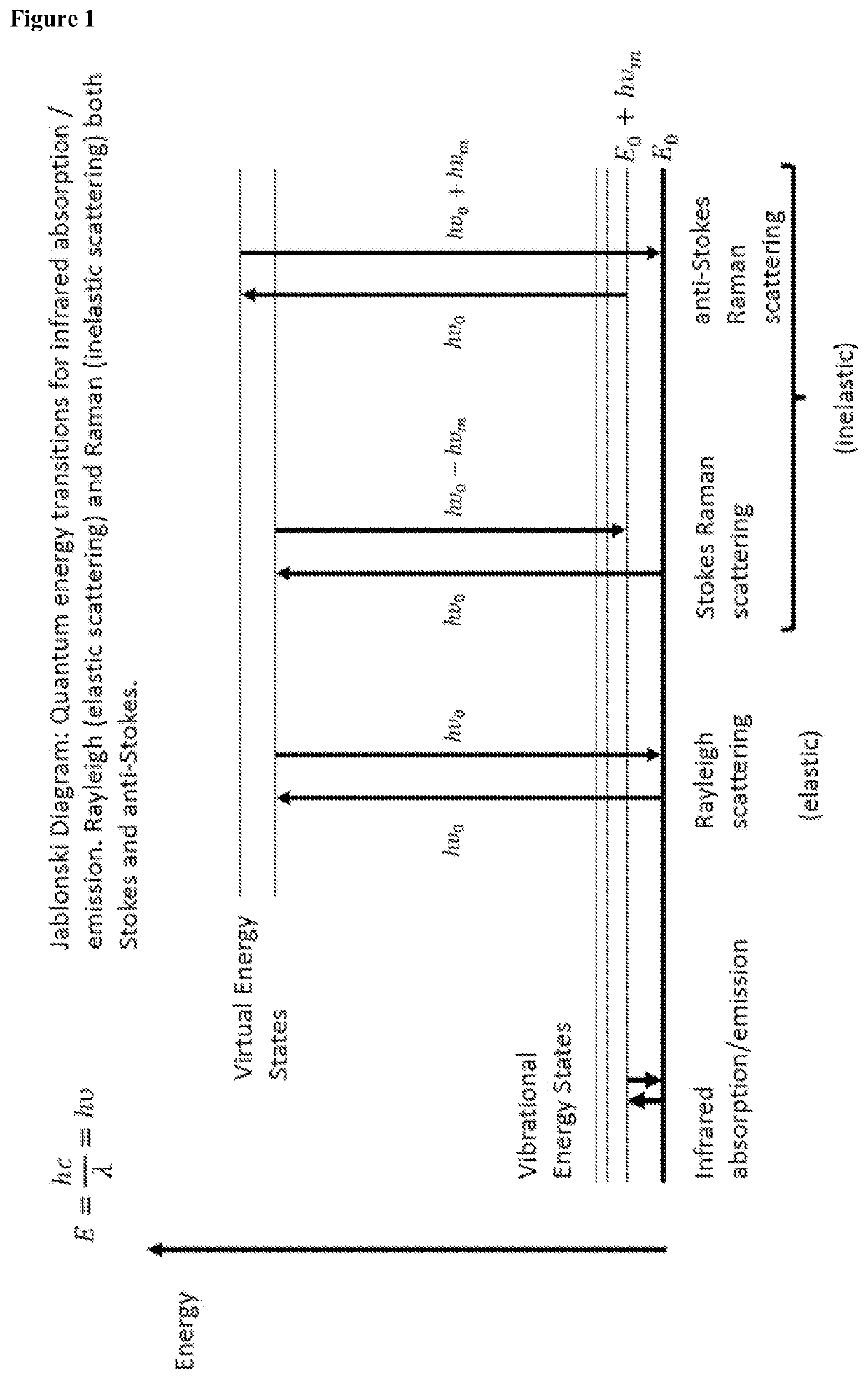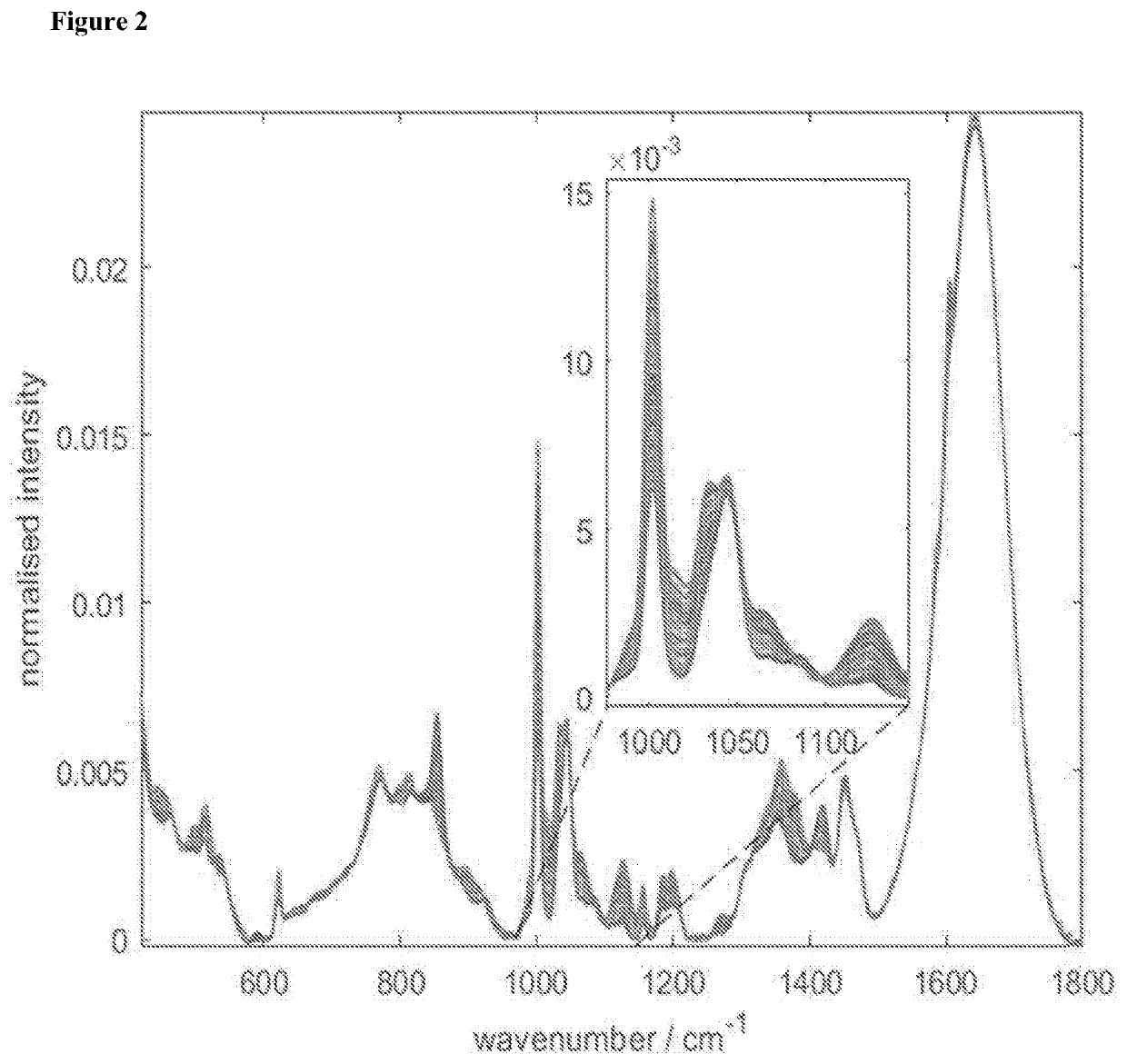Methods for determining viral titre using raman spectroscopy
a raman spectroscopy and viral titre technology, applied in the direction of optical radiation measurement, instruments, spectrometry/spectrophotometry/monochromators, etc., can solve the problems of retrospective measurement of viral concentration, limited generic application of technology, and time-consuming methods, so as to achieve accurate measurement, fast and simple, accurate results
- Summary
- Abstract
- Description
- Claims
- Application Information
AI Technical Summary
Benefits of technology
Problems solved by technology
Method used
Image
Examples
example 1
on of Concentration of Lentivirus at Different Stages During the Production Process
[0169]Calculations were performed to provide estimated lentiviral concentrations in mg / ml expected at different stages during an example viral production process. The concentrations were calculated using the known buoyant density of lentivirus and the physical titre. The results are shown in the table below.
ParameterValueUnitsCommentsBuoyant1.15E+00g / cm3Actual range is 1.15 - 1.19Densityg / ml using the lower valuefor conservative estimate.Particle7.50E−08mRadiusParticle1.50E−07mDiameter of a lentivirus isDiameterapproximately 0.15-0.2microns, using the lowervalue for a conservativeestimate.Volume of1.77E-21m34 / 3 × pi × r3a ParticleVolume of1.77E-15cm3a particleMass of a2.03E-15gParticleTypical1.00E+08particles / mlphysical titres 100-1000 ×Physicalgreater than copy numberTitre (a)from qPCR.Typical1.00E+07particles / mlPhysicalTitre (b)Typical1.00E+09particles / mlPhysicalTitre (c)Typical1.00E+10particles / mlP...
example 2
l Production from a HEK 293 Transient Process
[0194]Experimental Methods
[0195]Cell Culture and Transient Transfection
[0196]HEK293 cultures were expanded in Eppendorf DASbox BioBLU 300 bioreactors in FreeStyle 293 expression medium (ThermoFisher) with no additional supplements at 37° C. The cells were agitated and were expanded for 2 days prior to transient transfection to produce lentivirus. The cells were transfected with gag-pol,vsv-g and genome encoding eGFP to produce LV particles using PEIPro from Polyplus.
[0197]Throughout the process 10 or 12 samples were acquired from each bioreactor to measure viral titre using qRT-PCR and confirmed by P24 ELISA. Raman spectra were acquired throughout the expansion and viral production phases.
[0198]RT-qPCR
[0199]PCR kit Used: Lenti-X™ qRT-PCR Titration Kit (by Takara, Cat #631235)
[0200]Suppliers: Clontech
[0201]Method of action: the kit is a one-step reverse transcription and PCR amplification kit. The primers of this kit target a conserved reg...
example 3
iral Titre Model Evaluation and Range Selection
[0219]Further studies using additional samples were performed using the same methodologies as described above for Example 2 in order to further refine the wavenumber range selection for viral titre evaluation. Using this approach various wavenumber ranges were identified for use in calculating viral titre by applying a variable importance projection (VIP) threshold of ≥1.00. Additional wavenumber ranges were identified by applying a variable importance projection (VIP) threshold of ≥1.25 and further wavenumber ranges were identified for by applying a variable importance projection (VIP) threshold of ≥1.50. The results are presented in Table 1 above.
[0220]FIG. 12 shows an outline schematic of a formula for quantifying viral titre. The formula is applied to the regression coefficients which are obtained from the multivariate regression algorithm which was applied to normalised Raman signal intensity data.
[0221]A further analysis was perfo...
PUM
| Property | Measurement | Unit |
|---|---|---|
| wavelength | aaaaa | aaaaa |
| Raman spectroscopy | aaaaa | aaaaa |
| Raman | aaaaa | aaaaa |
Abstract
Description
Claims
Application Information
 Login to View More
Login to View More - R&D
- Intellectual Property
- Life Sciences
- Materials
- Tech Scout
- Unparalleled Data Quality
- Higher Quality Content
- 60% Fewer Hallucinations
Browse by: Latest US Patents, China's latest patents, Technical Efficacy Thesaurus, Application Domain, Technology Topic, Popular Technical Reports.
© 2025 PatSnap. All rights reserved.Legal|Privacy policy|Modern Slavery Act Transparency Statement|Sitemap|About US| Contact US: help@patsnap.com



